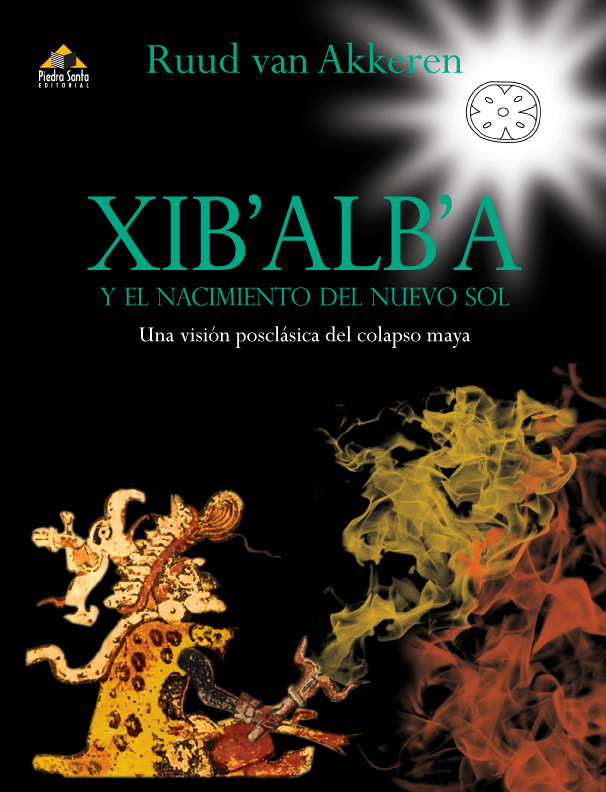Xibalba y el nacimiento del nuevo sol
Una visión posclásica del colapso maya
Classic Maya scholars very often argue that you can’t use the Popol Wuj to reconstruct Classic Maya thought, cosmology or history because, as they say, it was written by ‘different’ Maya. I show in this book that its authors, the Kaweq lineage, actually had a Classic origin in the northern Verapaz and southern Petén area, covering sites like Chama, Salinas, Candelaria Caves, Cancuen and Machaquila. Moreover, they were strongly connected with the Kanek’, a lineage that was very active during the Terminal Classic in the entire Maya Lowlands and the peninsula Yucatan.
Xibalba is the name for the Maya underworld. The Xibalba myth takes up about two fifths of the Popol Wuj. Though a myth, I prove in the book that there was a historical and geographical Xibalba. It was always there in the text of the Popol Wuj, but never really recognized by its translators. Kaweq authors locate Xibalba in Nim Xol-Karchaj. Karchaj is a reference to the town of San Pedro Carcha and Nim Xol is abarrio of Cobán, called Santo Tomás Nim Xol. Yet Cobán and Carcha are colonial towns, the result of the Spanish policy of reducción. An historical analysis of the origin of the people who ended up living in the various barrios of these towns, reveals they are a mix of Q’eqchi’ and Ch’ol-speaking Maya from northern Alta Verapaz, a region riddled with caves like those of La Candelaria, the second largest cavern system in the Maya area.
In Xib’alb’a y el nacimiento del nuevo sol, I began defining the two paradigms which pervaded – and still pervade – Mesoamerican thought and cosmology. They represent a pair of mythological complexes centered on the two main elements of creation: light and food, sun and maize. They were embodied in Maya cosmology by two protagonists: Sun Hero and Maize Hero. They appear to be complementary paradigms: the first one is masculine, the second feminine; the first one represents the periphery, the second, the center; the first one is connected with the color white and the glyph k’in, the second with the color yellow and the glyph k’an. Hence the front- and the backcover of the book.
It has gone unnoticed by many scholars, but Jun Ajpuuh actually dies two times in the Xibalba tale. He is a fusion of both paradigms. He is first decapitated in the ballcourt, and later incinerated in the sacred hearth. As for the ballcourt, in its very essence and therefore in its shape, it represents a furrow on a maize field, and the decapitated head of the Maize Hero, the sown maize kernel. Thus when losing his head in the ballcourt, we find Jun Ajpuuh embodying the Maize Hero. Yet in the divine hearth, that is, the terrestrial fire, he dies again and gets reborn as the celestial fire, becoming Sun Hero. In both cases he is restored to life. At the end of the Xibalba myth, both elements, the maize plant and the sun, are present to begin the new era, that of the K’iche’ confederation.
The Kaweq authors produced this fine and unparalleled myth about the Maya underworld because Xibalba was their cradle, their place of origin. I further show that their patron goddess Xmukane represented the entrance to this underworld. They lived through the end of the Classic, through times of turmoil and having survived them, they saw themselves as the dwellers of the new epoch – indeed, the first man molded from corn dough by Xmukane is Balam K’itze’, founding father of the Kaweq. They later forged this cultural collapse of the Classic Lowland Maya into a literary format of this stunning myth. Hence the subtitle of the book: ‘Una visión posclasica del colapso maya’.
There are many more new insights in this book – too many to mention, but they can be found on the website Mesoweb
http://www.mesoweb.com/books/featured/media/VanAkkeren2012-abstract.pdf
“The book Xib’alb’a y el nacimiento del nuevo sol written by Dr. Ruud van Akkeren is truly a “masterpiece”, an incredible synthesis of a vast amount of data from many fields of research. It is noteworthy that, although it has a length of 250 pages, it is printed in a three column format, so in fact it is a text of more than 700 pages. It is also an unusual, if not unique, work in terms of its truly multidisciplinary breadth. It incorporates ethnohistory, archaeology, epigraphy, ethnography and linguistics, as well as art history and iconographic interpretation. The many new insights it presents are the result of its bold multidisciplinary methodology. This is rarely observed, given the restrictions imposed by academic disciplines, which makes it difficult to speak beyond the chosen subfield. This work also has a tremendous geographic breadth, as it synthesizes the data and cultural history of the entire region of eastern Mesoamerica, including Petén, the Guatemalan Highlands, the Gulf Coast of Mexico, Yucatan, and also includes something of relevant information from the Center of Mexico. Such an interregional perspective is also very unusual, especially in the field of archeology, because we specialize too in specific regions, which inhibits us from offering more ambitious interpretations.”
Arthur Demarest 2013
Vanderbilt University and director of the Cancuen Project.
Author of various books on the subject of the Classic Maya collapse.

